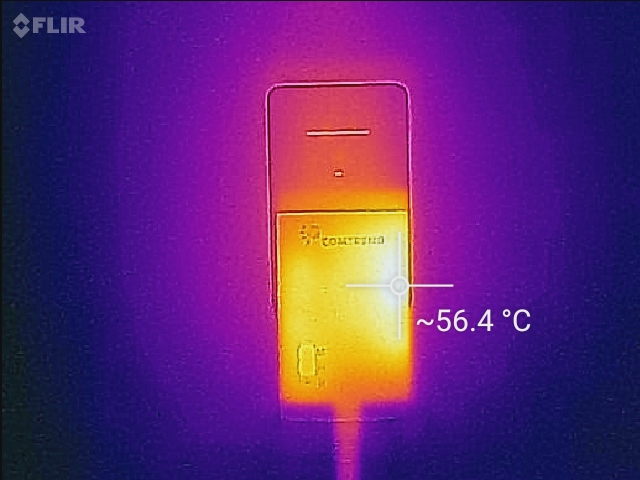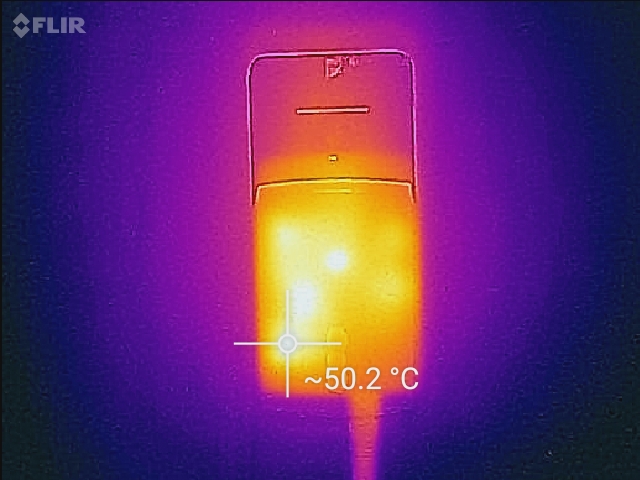Comtrend PG-9172 Powerline Adapter Review: G.hn Gets Primed for Retail Push
by Ganesh T S on May 3, 2016 8:30 AM EST- Posted in
- Powerline Adapters
- Networking
- Marvell
- G.hn
- HomePlug
- Comtrend
Miscellaneous Aspects - Power, Thermals and Coexistence
Powerline adapters tend to get quite warm under sustained loading conditions. The power consumption is also an interesting aspect, since these devices are kept on 24x7. We evaluated these aspects for the Comtrend PG-9172 and the ZyXEL PLA5405. While the master node was left as-is (with the DHCP server NUC connected) in the 'M' location in the floorplan, the other member of the adapter pair was connected to a Ubiquiti Networks mFi In-Wall outlet in the same room as Node C. The In-Wall outlet allows measurement of instantaneous power consumption.
A stress test was set up with iperf servers and clients running on the NUCs at either end. 16-stream TCP benchmarks were processed for 30 minutes from both sides simultaneously.
Under these sustained loading conditions, the G.hn pair was able to maintain 60 Mbps+ uplink and downlink, while the HPAV2 MIMO pair was able to maintain around 40 Mbps
At the end of the 30 minute stress test, thermal photographs of both units were taken using the FLIR One for Android thermal camera.
We find that the G.hn adapter ran hotter (more than 56C) compared to the HPAV2 adapter (around 50C)
The power consumption of the adapters was also recorded under different scenarios. Under stress, the HPAV2 adapter does consume more power than the G.hn adapter. However, the thermal design must be better in the former in order to maintain a lower case temperature. On the other hand, under idle conditions, the disabling of the power saving feature by default in the G.hn adapter results in much higher power consumption compared to the HPAV2 adapter.
| PLC Adapter Power Consumption | ||
| Scenario | Comtrend PG-9172 | ZyXEL PLA5405 |
| Normal (No Traffic) | 3.19 W | 1.98 W |
| Stress Test (TCP) | 3.85 W | 3.97 W |
Coexistence is important if G.hn adapters end up getting installed in apartments with pre-existing HomePlug networks. Marvell has been working on updating the firmware to improve coexistence. Even though our review units were not equipped with the latest coexistence firmware, we decided to test out whether HomePlug and G.hn networks could co-exist. Towards this, we created a HomePlug AV2 network to extend our primary network (192.168.1.0 subnet) and retained the G.hn network described above. The HPAV2 network's master node was connected to a power outlet in the wall adjacent to the G.hn master node.
Traffic in our primary HPAV2 network was restricted to a series of pings (over Wi-Fi to a PC connected to the second powerline adapter). In this scenario, we processed the stress test on the G.hn network. There is a clear loss of bandwidth, and the consistency exhibited in the previous run was no longer present. However, it did manage to stay above 35 Mbps all through. On the HPAV2 side, we lost around 4 packets out of a few thousand. On the whole, our conclusion regarding coexistence is that it works in our limited testing. Future firmware updates might help lessen the impact on the HPAV2 network while also enabling the G.hn network to have better performance consistency.















48 Comments
View All Comments
Murloc - Tuesday, May 3, 2016 - link
powerline has always been a pain for me, it's less hassle to call up the electrician and get a cable pulled. It costs money and it needs space in the wall but at least it works with decent speed.Samus - Tuesday, May 3, 2016 - link
I've never had it work well unless you use it on circuits of the same phase. It seems as soon as you cross phases the reliability and speed fall off significantly.magreen - Wednesday, May 4, 2016 - link
Agreed. I don't think powerline has ever lived up to its billing.I think coax is the way for people who don't want to pull cable. Old cheap DECA units handle 100Mbps flawlessly. Newer bonded MOCA units are pushing actual throughput of 1 gigabit.
kmmatney - Wednesday, May 4, 2016 - link
I wasn't able to get my powerline adapters to work with my desired sockets, so had to use another plug across the room. And then one of the adapters failed after about 2 years. I switched to a cheap programmable wireless adapter. You just connected it to a computer to input your wireless settings, and then it worked on it's own after that. The wireless solution was much cheaper and overall less hassle.barleyguy - Friday, May 6, 2016 - link
I've had pretty good luck with speeds with some TP-Link powerline adapters, but I'm getting rid of them anyway and moving to 802.11AC. The problem is that they create noise on the electrical line, and I can hear it in my speakers when there's not music playing. I don't feel like the utility is worth the hassle either.cswilly - Tuesday, May 3, 2016 - link
Informative review. Looking forward to your testing with BRCM's AV2 part. As it uses 2-87MHz it should outperform Marvell's G.hn on good links.spawnbsd - Tuesday, May 3, 2016 - link
Marvell's 2nd gen 88LX5153 are starting to sample now, and support 2-100MHz in powerline MIMO. In the limited testing we've done in our labs, we're seeing near ~1Gbps throughput in common powerline topologies. Hopefully some hit retail sooner rather than later.morgi - Thursday, May 5, 2016 - link
that is awesome! what lab are you working in?Is it real TCP traffic?
nathanddrews - Tuesday, May 3, 2016 - link
It's a real shame that powerline networking hasn't received more interest and R&D. It's the perfect backbone for IoT, home automation, and retrofitting older homes that don't have ethernet or homes that struggle with radio interference.hojnikb - Tuesday, May 3, 2016 - link
I also wonder why its not adopted as a wide area network ie for internet. Instead of using phone lines use existing power network.